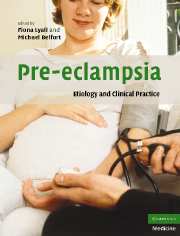Book contents
- Frontmatter
- Contents
- List of contributors
- Preface
- Part I Basic science
- 1 Trophoblast invasion in pre-eclampsia and other pregnancy disorders
- 2 Development of the utero-placental circulation: purported mechanisms for cytotrophoblast invasion in normal pregnancy and pre-eclampsia
- 3 In vitro models for studying pre-eclampsia
- 4 Endothelial factors
- 5 The renin–angiotensin system in pre-eclampsia
- 6 Immunological factors and placentation: implications for pre-eclampsia
- 7 Immunological factors and placentation: implications for pre-eclampsia
- 8 The role of oxidative stress in pre-eclampsia
- 9 Placental hypoxia, hyperoxia and ischemia–reperfusion injury in pre-eclampsia
- 10 Tenney–Parker changes and apoptotic versus necrotic shedding of trophoblast in normal pregnancy and pre-eclampsia
- 11 Dyslipidemia and pre-eclampsia
- 12 Pre-eclampsia a two-stage disorder: what is the linkage? Are there directed fetal/placental signals?
- 13 High altitude and pre-eclampsia
- 14 The use of mouse models to explore fetal–maternal interactions underlying pre-eclampsia
- 15 Prediction of pre-eclampsia
- 16 Long-term implications of pre-eclampsia for maternal health
- Part II Clinical Practice
- Subject index
- References
15 - Prediction of pre-eclampsia
from Part I - Basic science
Published online by Cambridge University Press: 03 September 2009
- Frontmatter
- Contents
- List of contributors
- Preface
- Part I Basic science
- 1 Trophoblast invasion in pre-eclampsia and other pregnancy disorders
- 2 Development of the utero-placental circulation: purported mechanisms for cytotrophoblast invasion in normal pregnancy and pre-eclampsia
- 3 In vitro models for studying pre-eclampsia
- 4 Endothelial factors
- 5 The renin–angiotensin system in pre-eclampsia
- 6 Immunological factors and placentation: implications for pre-eclampsia
- 7 Immunological factors and placentation: implications for pre-eclampsia
- 8 The role of oxidative stress in pre-eclampsia
- 9 Placental hypoxia, hyperoxia and ischemia–reperfusion injury in pre-eclampsia
- 10 Tenney–Parker changes and apoptotic versus necrotic shedding of trophoblast in normal pregnancy and pre-eclampsia
- 11 Dyslipidemia and pre-eclampsia
- 12 Pre-eclampsia a two-stage disorder: what is the linkage? Are there directed fetal/placental signals?
- 13 High altitude and pre-eclampsia
- 14 The use of mouse models to explore fetal–maternal interactions underlying pre-eclampsia
- 15 Prediction of pre-eclampsia
- 16 Long-term implications of pre-eclampsia for maternal health
- Part II Clinical Practice
- Subject index
- References
Summary
Summary
Pre-eclampsia is associated with significant maternal and fetal morbidity and mortality worldwide. While provision of adequate antenatal care would significantly reduce morbidity and mortality in third-world countries, in first-world countries efforts are being focused on identification of at-risk patients and on targeted therapies. Pre-eclampsia can be distinguished as early (<34 weeks gestation) and late (>34 weeks) onset phenotypes. While these have been thought traditionally to be synonymous with severe and mild disease phenotypes, respectively, recent analyses show that an appreciable amount of severe disease is also late onset. There is evolving evidence that there are different underlying etiologies that ultimately lead to this syndrome defined by hypertension, proteinuria and edema. It is unlikely that one single biomarker will identify all individuals destined to develop pre-eclampsia. Rather, panels of biomarkers specific for the different phenotypes may identify those at risk for pre-eclampsia prior to the appearance of overt disease. Importantly, these measurements may also provide different (biochemical) definitions of disease. In order to have a significant impact on clinical or economic outcome it is vital to identify women who will develop early onset disease or severe disease, as these phenotypes are those associated with significant morbidity and mortality. Similarly, therapies must be targeted at these same outcomes and not just the appearance of hypertension and proteinuria at term. While there is abundant evidence in the literature for changes in expression or concentration of many biomarkers in established disease, there is still a dearth of prospective studies with well-defined clinical outcomes in which prospective measurement of biomarkers have been made.
- Type
- Chapter
- Information
- Pre-eclampsiaEtiology and Clinical Practice, pp. 215 - 231Publisher: Cambridge University PressPrint publication year: 2007



